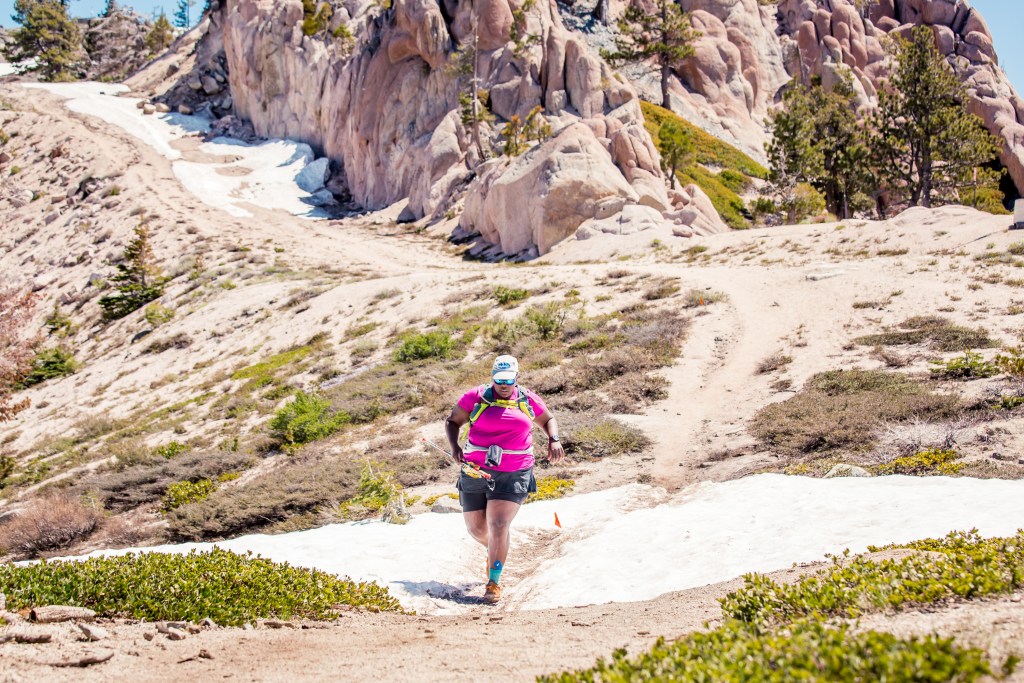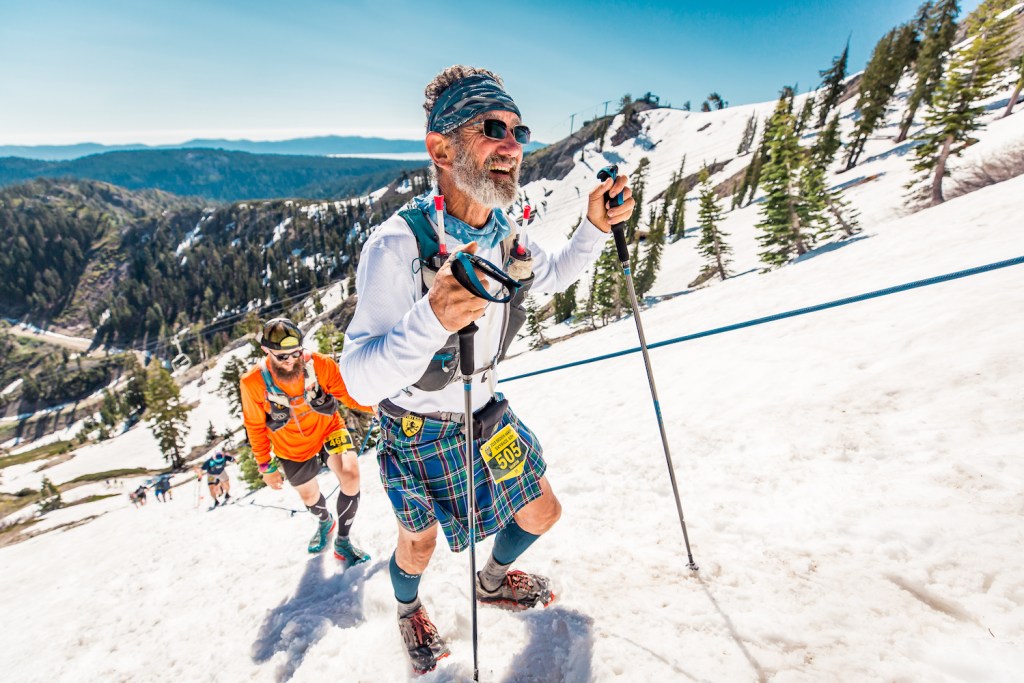On July 4, 1993, dawn arrived early on Monte Rosa’s 15,203-foot summit in Italy. More than 10,000 feet below, in the village of Alagna Valsesia, a ski guide named Lauri van Houten hurried to a new off-season gig: directing a race organized by Italian mountaineer Marino Giacometti.
Seven runners lined up at the start. Their objective: a direct line up Monte Rosa. They raced on dirt paths, scrambled through scree fields, slogged over glaciers and snow, then rocketed downhill to finish the 21-mile route after nearly 23,000 feet of climbing and descending.
Hikers on this route typically rode three cable cars and climbed 4,000-plus feet to complete the trip in around 36 hours. But the winner of that race in 1993, an Italian mountain runner named Fabio Meraldi, careened back into town after just four hours, 24 minutes. Gisella Bendotti took the women’s title 70 minutes later. “It was one hell of a performance,” said van Houten. “I thought they were superhuman. I still think the same today.”
This race marked the beginning of a niche sport called skyrunning, which is defined by direct ascents over steep, technical terrain with massive vertical gain. Today, the International Skyrunning Federation (ISF)—Giacometti is the president; van Houten the executive director—counts 202 races in 18 countries, with 50,000 participants annually.
The United States is well represented: the Skyrunner USA National Series includes 17 races across seven states. Team USA claimed bronze at the 2018 Skyrunning World Championships. On July 28, in a winner-takes-all throwdown, the inaugural Skyrunning North American Championship will be held at Colorado’s Barr Trail Mountain Race.

Mirna Valerio competes in the Broken Arrow Skyrace at Squaw Valley, California. (Photo Credit: Hilary Matheson)
So, where did the idea for skyrunning come from? Think of the sport as a modern take on a European tradition. The Alps gave us professional mountain guides in the late 1800s; since then, mountaineers have used the landscape as a research lab for ever faster and more efficient means of mountain travel.
The idea for races took shape thanks to Giacometti. As a child, he ran 7 miles a day for his school commute. He grew into a mountaineer focused on light and fast ascents on high-altitude peaks. Before the 1993 race, Giacometti had attempted to set the Monte Rosa speed record.
Skyrunning became more widespread after Giacometti met the CEO of an Italian sporting goods company on a Himalayan expedition. That company sponsored races in North America, Europe, Asia and Africa. Americans excelled: Colorado’s Matt Carpenter won the Everest SkyMarathon Tibet five times. But the tour crumbled in the late ’90s due to sponsorship issues.
Van Houten and Giacometti regrouped in 2008 to launch the ISF, which licenses events worldwide. The ISF defined skyrunning as courses above 6,500 feet in elevation and with inclines over 30 percent. “Imagine going up stairs—but there’s no stairs, just snow,” said van Houten. Races include a 16-hour cut-off time to protect athletes from sleep-deprived missteps in high-consequence terrain.
While American geography often means competitions happen at lower altitudes than in say, the Himalaya, the main features translate. “There’s an element of mountaineering in every event,” said Ryan Kerrigan, who heads the U.S. Skyrunning national team, which was established in 2018. “There will be snow, altitude, maybe a rope traverse and at some point you will need to use your hands.”
Steep descents are also a must. “Trail running goes around the mountain,” said van Houten. “Skyrunning goes up and down it.”
By the time the ISF hosted the first Skyrunning World Championships in Italy in 2010, trail running was on the rise in the U.S. But it was trickier to pull off skyrunning races in this country since public lands managers were vetoing races in sensitive environmental areas.
Then skyrunning race directors found an ideal venue: ski resorts with unfettered uphill access. A U.S. series debuted at various ski resorts in 2014. Athletes earned points toward the title in races across three divisions.

Steep ascents and descents are an integral part of skyrunning races. (Photo Credit: Hilary Matheson)
Still, participation lagged. “We modeled the U.S. market off what they had done in Europe, which put people in a format where they had no idea what it was,” said Rob Goyen, director of the Skyrunner USA, a revamped national series that launched last year and added a short-distance course under 6 miles.
This new, shorter-race addition expanded skyrunning beyond ski mountaineers and ultrarunners to newcomers looking for an entry point. “The change in participation rate looks like a skyrunning elevation profile,” said David Roche, a coach who’s worked with three national series champions. “People are hearing the siren call of nature and see a meaningful challenge.”
Look at California’s Broken Arrow Skyrace, held on the slopes of Squaw Valley ski area in June. In 2016, there were 145 runners in the long distance race, 113 signed up for the middle distance and 104 entries in the short race. Those numbers roughly tripled for the 2019 race.
More elite runners feel the draw, too. “In the U.S., there’s still a bigger emphasis on old school 100-milers,” said Dani Moreno, the 2018 U.S. national skyrunning champion. “But if you jump in too quickly, wear and tear can lead to injury. So younger folks like myself may not want to run that far, but we still want to compete. What’s the middle ground? Skyrunning.”
A U.S. talent pipeline has also developed. This August, U.S. Skyrunning will bring athletes between 15 and 22 years old to the Youth Skyrunning World Championships for the third time.
But skyrunning isn’t restricted to elite athletes. “For a runner who’s already fit, it’s just about practicing specific movement patterns,” said Roche. To prepare for steep terrain, he recommends a workout with heavy downhills every two to three weeks—even repeats on a 100-foot hill works.
Spectators can catch a thrill, too. Take a ski lift to a lofty perch on course to watch leaders glide over jumbled rocks with the grace of a snow leopard. “It’s dramatic in the middle or back of the pack too, where this race is one of the hardest things people have ever done in their lives,” said Kerrigan. “They’ll finish completely bonked and burst into tears—or totally elated, covered in dirt and blood.”
